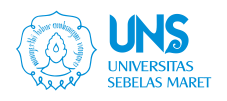ANALYSIS OF STEM COMPONENTS AND SCIENCE LITERACY IN CLASS X CHEMISTRY TEXTBOOK MERDEKA CURRICULUM ON ATOMIC STRUCTURE MATERIAL
Abstract
Keywords
Full Text:
PDFReferences
[1] I. W. Redhana, “Mengembangkan Keterampilan Abad Ke-21 dalam Pembelajaran Kimia,” J. Inov. Pendidik. Kim., vol. 13, no. 1, pp. 2239–2253, 2019.
[2] BSNP, “Laporan BSNP Tahun 2010,” 2010.
[3] C. E. Anggraini and T. Nurita, “Analisis Buku Ajar SMP Terkait Komponen STEM (Science, Technology, Engineering, Mathematics) pada Materi Tekanan Zat,” Pensa E-Jurnal Pendidik. Sains, vol. 9, no. 3, pp. 282–288, 2021, [Online]. Available: https://ejournal.unesa.ac.id/index.php/pensa.
[4] Kementerian Pendidikan Kebudayaan Riset dan Teknologi, “Keputusan Kepala BSKAP Nomor 033/H/KR/2022.” 2022.
[5] L. Thibaut et al., “Integrated STEM Education: A Systematic Review of Instructional Practice in Secondary Education,” Eur. J. STEM Educ., vol. 3, no. 1, pp. 1–12, 2018, doi: 10.20897/ejsteme/85525.
[6] T. Hadinugrahaningsih, Y. Rahmawati, and A. Ridwan, “Developing 21st Century Skills in Chemistry Classrooms: Opportunities and Challenges of STEAM Integration,” AIP Conf. Proc., vol. 1868, no. August, 2017, doi: 10.1063/1.4995107.
[7] OECD, The Pisa 2003 Assessment Framework. Paris, 2003.
[8] OECD, “PISA 2018 Results Combined Executive Summaries,” 2019.
[9] Kementerian Pendidikan Kebudayaan Riset dan Teknologi, “Keputusan Menteri Pendidikan, Kebudayaan, Riset dan Teknologi Republik Indonesia Nomor 56/M/2022 tentang Pedoman Penerapan Kurikulum dalam Rangka Pemulihan Pembelajaran.” 2022.
[10] L. A. Agnezi, N. Khair, and S. Yolanda, “Analisis Sajian Buku Ajar Fisika SMA Kelas X Semester 1 Terkait Komponen Science, Technology, Engineering, Mathematics (STEM),” J. Eksakta Pendidik., vol. 3, no. 2, p. 167, 2019, doi: 10.24036/jep/vol3-iss1/381.
[11] S. Sukaesih and N. E. Kartijono, “Pengembangan Buku Ajar Microteaching Biologi Berbasis Kompetensi dan Karakter Konservasi,” J. Pendidik. IPA Indones., vol. 3, no. 1, pp. 79–85, 2014, [Online]. Available: http://journal.unnes.ac.id/nju/index.php/jpii.
[12] N. L. Rahmawati, Sudarmin, and K. K. Pukan, “Pengembangan Buku Saku IPA Terpadu Bilingual dengan Tema Bahan Kimia dalam Kehidupan Sebagai Bahan Ajar di MTs,” USEJ - Unnes Sci. Educ. J., vol. 2, no. 1, pp. 157–164, 2013, [Online]. Available: http://journal.unnes.ac.id/sju/index.php/usej.
[13] T. J. Kennedy and M. R. L. Odell, “Engaging Students In STEM Education,” Sci. Educ. Int., vol. 25, no. 3, pp. 246–258, 2014.
[14] R. W. Bybee, “What is STEM education?,” Science (80-. )., vol. 329, no. 5995, 2010, doi: 10.1126/science.1194998.
[15] E. L. Chiappetta, G. H. Sethna, and D. A. Fillman, “A Quantitative Analysis of High School Chemistry Textbooks for Scientific Literacy Themes and Expository Learning Aids,” vol. 28, no. 10, pp. 939–951, 1991.
[16] N. Maturradiyah and A. Rusilowati, “Analisis Buku Ajar Fisika SMA Kelas XII di Kabupaten Pati Berdasarkan Muatan Literasi Sains,” Unnes Phys. Educ. J., vol. 4, no. 1, pp. 16–20, 2015.
[17] Nurdini, I. M. Sari, and I. Suryana, “Analisis Buku Ajar Fisika SMA Kelas XI Semester 1 di Kota Bandung Berdasarkan Keseimbangan Aspek Literasi Sains,” J. Wahana Pendidik. Fis., vol. 3, no. 1, pp. 96–103, 2018.
[18] A. T. P. Retno, S. Saputro, and M. Ulfa, “Kajian Aspek Literasi Sains pada Buku Ajar Kimia SMA Kelas XI di Kabupaten Brebes,” Pros. Semin. Nas. Pendidik. Sains, pp. 112–123, 2017.
[19] R. A. A. Rauf, M. S. Rasul, A. N. Mansor, Z. Othman, and N. Lyndon, “Inculcation of Science Process Skills in a Science Classroom,” Asian Soc. Sci., vol. 9, no. 8, pp. 47–57, 2013, doi: 10.5539/ass.v9n8p47.
[20] S. Arikunto, Prosedur Penelitian Suatu Pendekatan Praktik, Jakarta: Rineka Cipta, 2013.Refbacks
- There are currently no refbacks.

